Training lesson: Geometric problems (for cutting)
The purpose of the lesson:
development of interest in the subject
development of students' creative abilities
development of attention, memory, skills of independent and collective work
development of amateur performance, quick wit and "ingenuity"
Course progress:
Today, geometric tasks (for cutting) will be associated with one seemingly simple geometric figure.
He has long been my friend
Every corner in it is straight.
All four sides
The same length.
I am glad to introduce him to you.
What is his name?
The main merit of the square was the use of it as a convenient unit of area. Indeed, it is very convenient to cover square sections with squares, but let's say that you cannot do this in circles without holes and overlays. Often, mathematicians instead of the words "finding the area" say "squaring."
So, the problem of finding the area of \u200b\u200ba circle is called the problem of squaring a circle. The square is the main character in the Pythagorean theorem.
Task number 1
Task number 2
Square of 20 equal triangles
Cut a square piece of paper into 20 equal triangles and fold 5 of them equal squares.
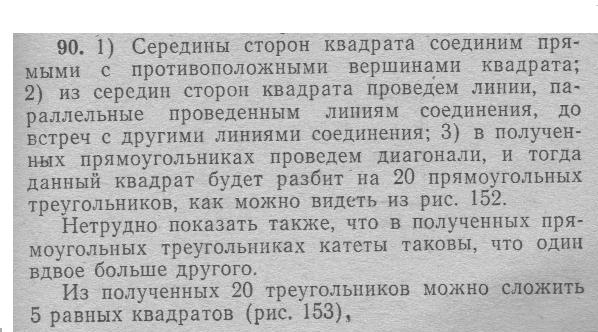

Task number 3
From the Cross - Square
A cross made up of five squares is required to be cut into parts from which one square could be made.
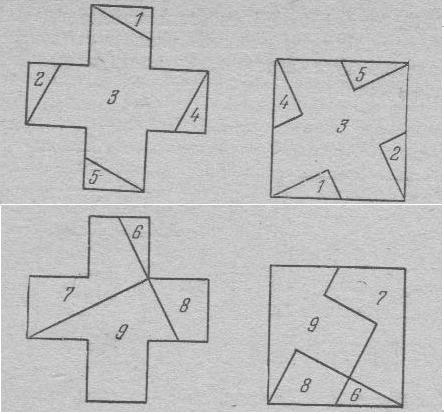
Task number 4
The square contains 16 cells. Divide the square into two equal parts so that the cut line runs along the sides of the cells.
There are several ways.
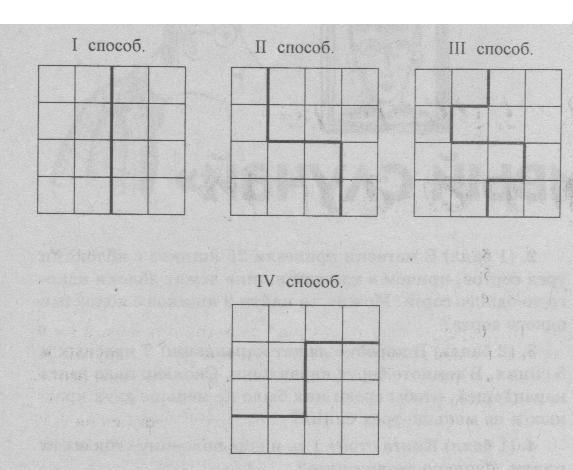

Task number 5
Cut a 7 × 7 square into five parts and shift them so that you get three squares: 2 × 2, 3 × 3 and 6 × 6.
Task number 6
Cut the square into 4 parts of the same shape and size so that exactly one hatched square falls into each part.
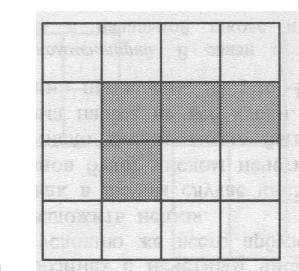

Task number 7
How many squares are there in the picture?
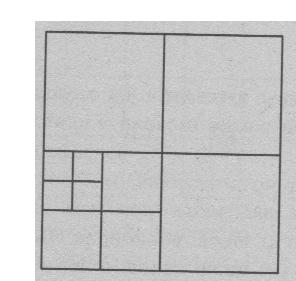
It is very simple to divide the square into smaller squares of the same area: it is enough to draw a grid of equally spaced straight lines parallel to the sides of the square. The number of squares received will be a square, yes, yes! That is why the product of two identical numbers was called a square. Is it possible to cut a square into several squares, among which there are no identical ones?
This issue has long remained unresolved. Many even outstanding mathematicians believed that such a cut is impossible. But in 1939, a square was divided into 55 different squares. In 1940, two methods were found for dividing a square into 28 different squares, followed by 26 squares, and in 1948 a division into 24 different squares was obtained. In 1978, a partition of 21 different squares was found, and it was proved that a partition into a smaller number of different squares could no longer be found.

And we’ll finish today's lesson with an entertaining game, also related to the square, “Tangram”

The figure shows a square, divided into 7 parts, from which you can add a variety of figures from the album provided by the teacher.
The sides are equal and all angles are straight. You can immediately divide the square into 4 equal squares or 4 identical triangles without any problems. But how to divide the square into six equal parts? This can be done with or without a ruler.
You will need
- - ruler;
- - a pencil;
- - paper.
Instruction manual
Divide the square into six parts - this means to get six geometric shapes, namely rectangles. To make the parts look the same, make the markup first. For example, a square has a side length of 24 cm. Ruler measure 12 cm on one side and 12 cm on the opposite (parallel). Connect the obtained points with a line that divides the square in half into two rectangles 24x12 cm in size.
Now continue marking, only on the other two sides (perpendicular to the already marked). Divide both sides (relative to each other) into 3 parts, while each of them will turn out to be 8 cm, connect the resulting points with lines. Thus, we get 6 identical rectangles 12x8 cm in size.
If there is no ruler and pencil at hand, and the square needs to be divided, then you can do without them. To do this, bend the figure exactly in the middle. Then, without unbending, fold the three-fold long rectangle obtained, carefully adjusting the formed sides. As a result, when folded, the rectangle that makes up 1/6 of the square will have a size of 12x8 cm. Expand the square and mark it with folds using a pen.
You can make the markup differently and also get 6 identical parts, only in this case they will already resemble long narrow strips. Mark the box. The length of the side is 24 cm, and in total you need to get 6 parts, therefore each fragment will have a width of 4 cm. To do this, use a ruler and a pencil to mark the points every 4 cm through one side of the square. Do the same with the other - opposite (parallel) side. Connect the resulting points. It turned out 6 identical, very elongated rectangles, which have the form of strips 24x4 cm in size.
It is impossible to break a square into 6 equal squares. It can be divided into 6 equal rectangles. Also, any square can be divided into 6 squares, 5 of which will be the same, and one will be larger than the others.
You will need
- - a pencil;
- - ruler;
- - scissors.
Instruction manual
To prove the impossibility of dividing the square into 6 equal squares, cut out 6 identical squares from paper. Of these, two combinations (6: 1, 2: 3) can be made, which are rectangles. To get a square from equal squares, take the number of cut squares that is the full square of another number (2 \u003d 4, 3 \u003d 9, 4 \u003d 16, etc.). This means that a square can be divided only into 4, 9, 16, 25, etc., equal squares, and cannot be divided into 6 equal squares.
If you need to divide into 6 equal geometric shapes, these can be rectangles. To do this, divide the two opposite sides of the square into three equal parts and connect the corresponding points. The result should be two segments perpendicular to the sides that you divided into three equal parts, and parallel to the other two sides of the square. Divide those two other sides in half and draw a line connecting the division points. As a result, 6 equal rectangles are formed.
Find the aspect ratio of any of the resulting rectangles. It will be 2: 3, regardless of the size of a large square. For example, if you need to divide into 6 parts a square with a side of 12 cm, then divide one side into 3 segments of 4 cm, and the second into 2 segments of 6 cm. By building perpendiculars to the division points, you will get 6 rectangles with sides of 4 and 6 cm Indeed, the ratio between the sides of the rectangle is 2: 3.
To divide a square into 6 squares, 5 of which are equal to each other, and 1 more than others, do the following:
Divide each side of the square into three equal parts -
draw a line connecting the two corresponding division points on opposite sides, it will be perpendicular to these sides -
draw a similar segment connecting the points of division of the other two sides of the square -
at their intersection get a square with a side equal to 2/3 of the side of the original square -
outside the constructed square there will be one square and two rectangles. Divide the rectangles in half with perpendiculars from the division points lying in the middle of their large sides, you get 4 more squares.
As a result, you get 5 equal squares whose sides will be 1/3 of the sides of the original square and 1 square whose sides are 2/3 of the original squares. For example, to divide a square with a side of 12 cm, calculate and build the side of the larger square: 12 2/3 \u003d 8 cm, then find the side of the small squares: 12 1/3 \u003d 4 cm.
Useful advice
For marking, take a sharp simple pencil - then the geometric shapes will turn out to be exactly the same in size.
Attention, only TODAY!
All interesting
Children's crafts, applications, modeling from plasticine, origami - all this is not only interesting, but also useful, as it develops artistic skills, taste, fine motor skills. Children love to build houses. They can be made from cubes and plasticine. Can…
Building a variety of geometric shapes is not only fascinating, but also useful. Ellipses, circles, rectangles, polygons and squares may be required for you to implement some design decisions, decorating ...
You can easily enter a square into a circle using drawing tools. But this problem is solved even with their complete absence. It is only necessary to remember some properties of the square.
You…
A square is a regular quadrangle in which all sides are equal and all angles are right. The perimeter of a square is the sum of the lengths of all its sides, and the area is the product of two sides or the square of one side. Based on the known relationships, through ...
The perimeter is the total length of all sides of the geometric figure. Usually it is found by adding the sizes of the sides. In the case of a regular polygon, the perimeter can be found by multiplying the length of the segment between the vertices by the number of such segments. ...
A square is a quadrangle consisting of four, equal in length, sides and four right angles. If necessary, you can get different geometric shapes from a square, for example, the same squares, only smaller, ...
It is impossible to break a square into 6 equal squares. It can be divided into 6 equal rectangles. Also, any square can be divided into 6 squares, 5 of which will be the same, and one will be larger than the others. You will need a pencil; - ...
A square is one of the simplest regular polygons. If there is a sheet from a notebook in a box, then the construction of this figure will not raise any questions. The same task using non-lined paper will take a little more time. And if at the same time ...
A square is a rectangle with equal parties. This is perhaps the simplest figure in planimetry. Due to the high degree of symmetry of this figure, to calculate the square area, just one of its characteristics is enough. It could be ...
Program tasks.
1. Fix the score within 10 (forward and reverse). Find the next, previous number.
2. To introduce the division of a square into four equal parts different ways
3. Learn to name parts and compare the whole and the part.
4. Exercise in the ability to see the shapes of familiar geometric shapes in surrounding objects.
5.Improve the ability to navigate on a sheet of paper, to determine the sides, corners and the middle of the sheet.
Demonstration material. Scissors, 2 squares, flannelograph, a sheet of paper with straight lines and circles in the corners and sides of which different color, a dot is drawn in the center of the sheet.
Handout. Squares, scissors, sheets of paper, color pencils.
Class progress
1. - Children, Pinocchio came to visit us today. He forgot how to count to 10 and vice versa. Will we help him?
Children count to 10 and vice versa. (2-3 children).
Children, he does not know the neighbors of number 5. Who will tell Dunno? Name the neighbors of number 7. Name the neighbors of number 3.
Children are called neighbors numbers.
2. Game exercise "Divide the square into parts"
Children, Pinocchio brought you a square and wants you to help him divide into four equal parts for him and his friends: Malvins, Artemon and Pierrot.
How many parts do we already know how to divide a square? (offer two called children to divide the square into two equal parts in different ways and explain their actions)
What figures did you get? (rectangles and triangles)
What can each part be called? What is more than a whole square or part of it?
Which is smaller: one second square or a whole square? How to get four equal parts? That's right, you need to cut each half in half.
3. Game exercise "Divide the square and show its parts"
Each child has a square and scissors on the tables.
Children, divide the squares into four equal parts in any way. I ask how to divide the square into four equal parts. Children divide the squares into four equal parts.
Let's play. I will give assignments, and you will show parts of the square. Make a whole square of four parts. Show one fourth (one second, two fourth, three fourth) part.
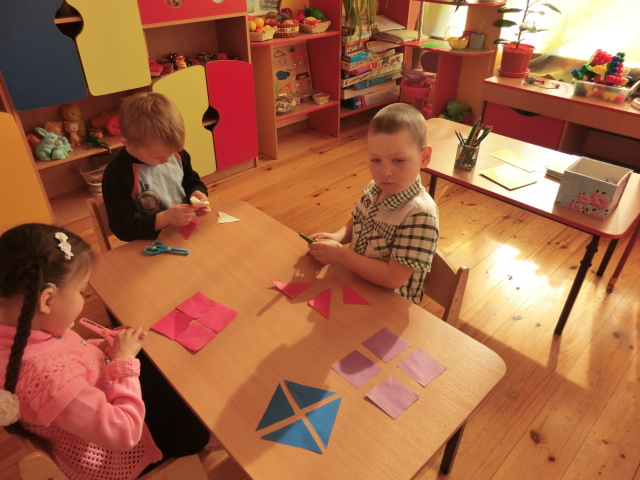
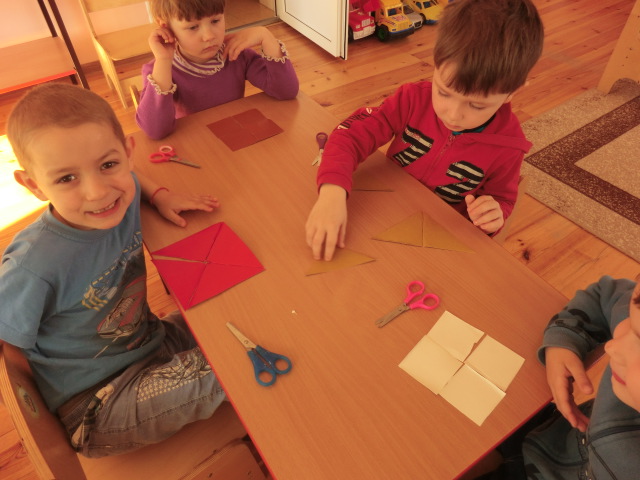
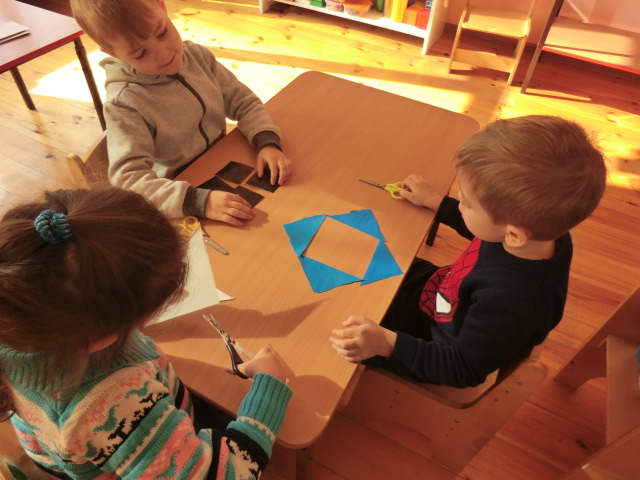

4.
Physical education: "Quickly get up, smile."
Stand up, smile
Higher, higher stretch.
Come straighten your shoulders
Raise, lower.
Right, left turned
My hands touched my knees.
Sat down, got up, got up.
And they ran on the spot.
Two claps overhead
Two claps in front of you.
We hide two hands behind our backs,
And on two legs we’ll jump.
Well done. Have a seat.
5 Let's see our next assignment.
Children, Pinocchio has prepared for you didactic andgras: “Name a similar subject.”
Guys, I will name the subject, and you will show me the corresponding figure. For example: the sun is round in shape, then we raise the circle. Then you yourself think and lift me the desired shape.
Door (rectangle), roof of the house (triangle), cube (square), cucumber (oval).
6. Let's play another one interesting game “Remember and repeat”
Children have sheets of paper and colored pencils.
Let's complete the tasks with you:
Draw a straight line along the top of the sheet with a red pencil (along the bottom side with a green pencil, along the left with a blue pencil, along the right with a yellow pencil);
In the upper left corner draw a circle with a red pencil (in the lower left corner with a blue pencil, in the upper right with a yellow pencil, in the lower right with a green pencil);
In the middle of the sheet, put a dot in red pencil.
After completing the assignment, the teacher asks “What and where did you draw?” (Children call the figure its color, location, and compare their work with the model of the teacher).
Children, Dunno and his friends are very satisfied, you coped with all the tasks.
Let's tell Pinocchio and his friends again what we did today?
I bring to your attention the ways and methods of dividing the square of the paper into an equal number of parts.
One of the ideals of origami requires folding the original square without preliminary drawings and measurements. With this folding, a problem arises if it is necessary to fold a sheet of paper, for example, three times. How to do this without resorting to a pencil?
This article addresses the issue of dividing a square sheet of paper into two, three, four, ... ten equal parts.
Dividing a sheet of paper into two parts is not difficult, because it is realized simply by folding the basic form of the book.

Let's move on to the more complex problem of dividing a square sheet into three parts. This task is not so simple. To solve it, we need the Hague theorem. Add the angle of the square to the middle of the opposite side. In this case, the intersection point of the other side, opposite this corner and the side adjacent to it, divides the side in relation to one to two. Thus, using only the folds, we found a third of the side of the square.
The next task is to divide the side of the square into four equal parts. To do this, it is enough to divide them in half, and then, each of the halves again in half. This is exactly what happens when we fold the basic shape of the door.

As you might guess, dividing a square into five parts by folding is a much more difficult task. Its solution is shown in the figure. Try to prove for yourself that in this way we really divide the square into exactly five parts.
In order to divide the side of the square into six parts, it is enough for us to divide it into three parts, as shown earlier. And then, divide each part in half.

You may notice that the division of the square by the number of parts, which is a prime number, causes particular difficulties.
We proceed to dividing the parties into seven identical parts. To do this, first divide the square into five equal parts, and then, do the action shown in the picture. Dividing the square into eight equal parts is quite simple. To do this, it is enough to divide it into four equal parts, and then divide each of them in half.

To divide the square into nine equal parts, two methods can be proposed. The first one is to divide first into three equal parts, and then repeat the division into three for a small square. However, this method is bad in that when applied in practice it will be difficult to maintain sufficient accuracy, since errors made at different stages are added together.
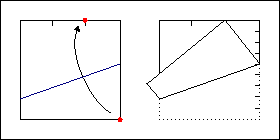
Another method is more original and based on the development of the Hag theorem, which was proposed by Koji and Mitsue Fushimi. Note that this method was used to divide the square into seven and nine parts. Maybe it is applicable for dividing it into nine parts?
And finally, dividing into ten parts is a sequential division into five parts, and then halving each of the five parts.

ARIGA ART |
Origami Lessons Themes and Works Origami Master Classes


